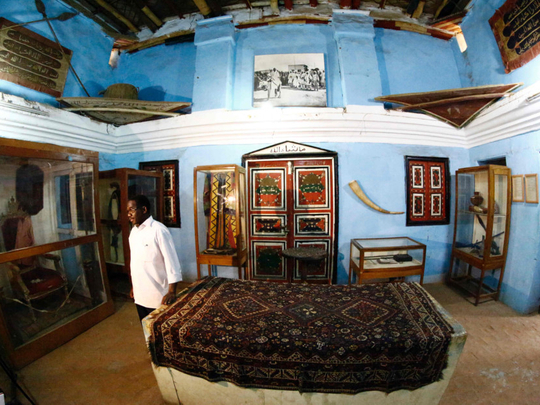
Al Fasher, Sudan: Tucked between palm trees and verdant lawns in the centre of Darfur’s Al Fasher, the palace of the restive Sudanese region’s last sultan has become a rare focus of pride, 100 years after his death.
Silver swords, antique rifles, richly coloured robes and even the throne from which autocrat Sultan Ali Dinar ruled Darfur’s vast expanses between 1891 and 1916 line the walls of the palace-museum.
Marginalised and underdeveloped since Dinar’s fall, the western Darfur region descended into bloody conflict in 2003 with millions of people forced to flee their homes, leaving the museum as one of the few traces of a rich past.
“The museum is a source of pride for all the tribes of Darfur,” said Eslam Abaker, an Al Fasher resident relaxing on the lawn in front of the palace.
“I came to see it first a year-and-a-half ago, but I have come back many times,” the 25-year-old said.
Cases display the silver coins minted as the region’s own currency, intricately decorated broadswords belonging to the sultan’s lieutenants and Dinar’s gold-painted throne.
Dinar was the last of the Keira dynasty of sultans to rule the region as absolute monarchs, controlling their subjects and raising revenue via an elaborate feudal system.
Hailing from the Fur ethnic group (Darfur means “domain of the Fur” in Arabic), Dinar’s reign came to an end in 1916 when he backed the Ottoman Empire at the height of the First World War.
Sudan’s British and Egyptian rulers sent troops to crush his rebellion, chancing on his camp in November that year and shooting him dead in the ensuing melee, before absorbing Darfur into Sudan.
Dinar’s descendants still live in Al Fasher – one even bears his title – but they can only imagine the power he wielded.
“When I go into the museum I get a strange feeling,” said Abdul Rahman Tijani Dinar, a great-grandson of the sultan.
The sprightly 73-year-old lives in Al Fasher not far from the palace and grew up hearing stories of his illustrious ancestor.
“I try to build up a picture of the sultan through the exhibits and through oral accounts,” he added proudly.
But the region’s heritage has been overshadowed by its dark recent past.
Ethnic minority insurgents in 2003 rebelled against President Omar Al Bashir, complaining that the region was being politically and economically marginalised by the Khartoum government.
The single Darfur that Dinar ruled was split into three states in 1994, with another two added in 2012, and last week the region’s conflict-weary residents voted on whether to return to a single region despite international criticism and a rebel boycott of the referendum. Voters overwhelmingly chose to maintain the status quo.
Darfur has long been neglected by successive Khartoum governments, a root cause of the current conflict, and the museum was created four decades ago at the behest of a local official.
“The museum was established in 1976 at the suggestion of Darfur Governor Al Tayeb Murdi to commemorate the sultan and protect his heritage,” its director Abdul Rahman Sadig said.
After a grand opening by then-president Jaafar Al Nimeiri in 1977, the number of daily visitors to the museum has since slowed to a trickle.
Like much else in Darfur, the palace has suffered years of neglect.
Its gardens, although lush and frequented by groups of students and residents chatting and relaxing, are overgrown and poorly maintained, with some annexes to the palace in serious disrepair.
In the exhibition itself, little explanation is given of the sultanate’s four-century history or the artifacts on display.
Relaxing on the palace lawns with friends, student Amnah Abdullah said she felt the palace was in need of greater funding from the government.
“Sultan Ali Dinar is a man who fought English colonialism to his death – he deserves more than a museum,” she said.
Darfur’s colonial rulers left 60 years ago when Sudan became independent but its problems did not end, with the region now in the 13th year of the insurgency that the United Nations says has killed at least 300,000 people.
Despite the palace’s condition and the less savoury aspects of Ali Dinar’s rule – his autocratic style, for example – his great-grandson also suggested the sultanate has become the focus of a certain pride for all Darfuris.
“What is not shown in the museum is that he has become the heritage of all people from Darfur, whatever their tribe,” Abdul Rahman Tijani Dinar said.












